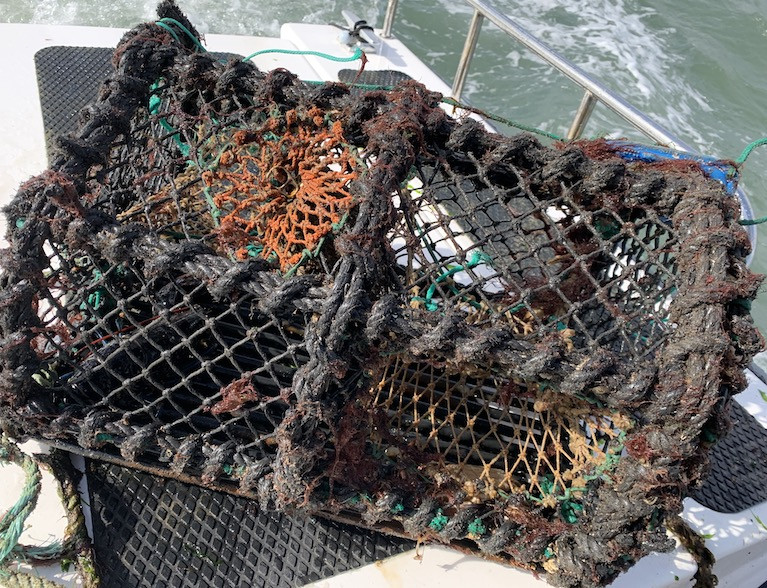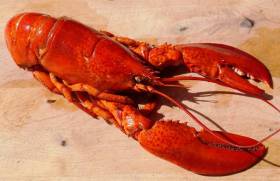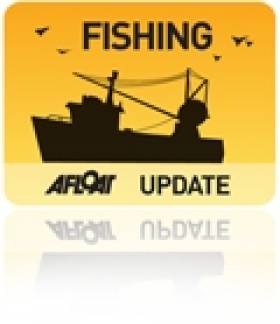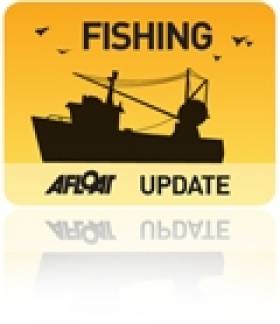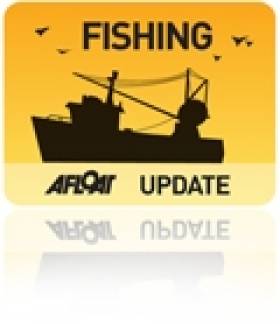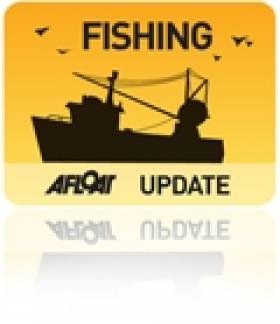Displaying items by tag: Lobster
European Spiny Lobster Juveniles Reared in Laboratory Setting by Corsican and French Scientists
French and Corsican marine scientists have succeeded in rearing juveniles of the vulnerable European spiny lobster.
A team from the University of Corsica and the French National Centre for Scientific Research (CNRS) has achieved what it terms a “scientific and technical feat”.
The team, with over ten years of experience in mastering the reproduction of vulnerable marine species, says it has reared an 11-month-old juvenile European spiny lobster, and they have reached the minimum release size required to initiate experiments in ecological restoration.
It says it is one of only two laboratories in the world to have mastered the reproduction of this species in such a setting – the other being RAS Aquaculture, run by Dr David Fletcher in Wales.
The spiny lobster, Palinurus elephas, can be found in the northeast Atlantic Ocean (from Norway to Mauritania), but especially in the Mediterranean.
Its southern distribution extends from North Africa to Morocco, the Canary Islands and the Azores.
Classified as a “ vulnerable species”, it is on the Red List of Threatened Species drawn up by the International Union for the Conservation of Nature (IUCN).
Its high selling price (50 to 100 € / kg) results from a relative scarcity, which has been confirmed by the continuous decline in catches recorded over fisheries of the European Union (from 1,100 tons in 1969 to 434 tons in 2017), the scientists say.
In France, on the Atlantic coast, fishing increased from 1000 tons a year in the 1950s to 25 tons. Catches also decreased dramatically off Corsica and Sardinia, where it accounted for a high proportion of local inshore fisheries.
The team says the objective of the study is “to use these individuals to restore depleted stocks”.
“For the Corsican fishing sector, lobster generates an annual income of more than 4 million euros. Lobster fishing alone accounts for up to 70% of the Corsican fisheries income,” the team says.
“This scientific advance could thus ensure the survival of Corsican artisanal fishing economy or even contribute to its development, while perpetuating a centuries-old heritage activity,” it says.
“This breakthrough is now paving the way for compensation methods for fishing activity to preserve the presence of the spiny lobster in its natural range,” it adds.
Record 40,000 Lobsters V-Notched in Ireland in 2022
More than 40,000 lobsters were v-notched in 2022, weighing almost 28 tonnes – the highest recorded since legislation began in 1995 to protect lobsters with such marks.
V-notching is a conservation tool carried out by Bord Iascaigh Mhara (BIM) trained Regional Officers around the coast of Ireland. Its primary aim is to protect female lobsters, giving them an opportunity to spawn and replenish stock while they are v-notched. The process is simple and involves removing a v-shaped notch from one of the flaps (uropods) on either side of the central part of the animal’s tail (telson) when it is first caught. If caught again, v-notched lobsters cannot be retained or offered for sale but must be returned to the sea where they and their offspring contribute to future recruitment.
Ian Lawler, BIM Development Manager, applauded the efforts of fishers involved in this year’s programme, supported by the European Maritime and Fisheries Fund.
“The 2022 v-notching programme was an exceptional year for all involved from the fishers who participated to the BIM regional staff who visited 94 piers along the Irish coast to v-notch lobsters throughout the year. It is a great collective effort that is enhancing the sustainability of a fishery that is the cornerstone of the Irish inshore sector.”
The 40,339 lobsters released in 2022 represent over 302 million larvae that will be released each time the lobsters spawn.
Irish lobster is highly sought after in Ireland and in continental markets, particularly in France, Spain and Portugal within food service and for home consumption. Lobster is in particular demand at Christmas and during other holidays such as Easter.
Sea Fisheries Protection Authority Urges Restaurants Not to Buy Shellfish from Recreational Fishers
Recreational fishers are urged to comply with regulations on catch, sale and purchase of crabs and lobsters, the Sea Fisheries Protection Authority (SFPA) has said.
The authority said it is also calling on all who purchase fish - and in particular those in the restaurant trade - to ensure that they purchase fish from legitimate sources only.
“They cannot purchase from recreational non-commercial fishers,” the SFPA has pointed out.
“It is important that all who are partaking in recreational fishing adhere to the regulations which are in place to protect the marine ecosystem and safeguard Ireland’s marine resources for future generations,”it said.
“ Whilst certain activities are allowed without a commercial license, there are limits in terms of quantities, and usage of fish. All such fish must comply with the general conservation requirements applicable to both commercial and recreational fishing,” it said.
Under EU and national legislation, recreational or non-commercial fishers who do not have a commercial fishing licence are restricted to doing no more than the following in pot fisheries:
- Fish for lobster and crab with pots from May 1st to September 30th only every year.
- Fish up to six pots (i.e., a maximum of 6 pots associated with their boat either in the water or on board at any time).
- Retain up to five crabs and one lobster daily.
- Eat their catch themselves or share with their immediate family – they cannot sell or offer for sale any catches (a commercial fishing license is needed to sell fish).
- Only land fish above the legal-size limits. In Irish waters the minimum size of brown crab is 140mm; spider crab (130mm for males and 125mm for females) and velvet crab 65mm, while lobsters must be a minimum size of 87mm and maximum size 127mm (carapace length).
- Anyone who catches a crab or lobster outside these size limits, must return it immediately to the sea.
- Never retain a lobster that has been V-notched or has a mutilated tail – they must be released back into the water.
- Never catch crabs or lobster by means of skin-diving, which includes using apparatus of any kind which enables a person to breathe underwater.
“We are privileged to enjoy a plentiful supply of fish stocks such as mackerel, crab, lobster, and others such as clams, mussels and periwinkles around our coastlines,” SFPA executive chair Paschal Hayes said.
“It is critically important that we all work to ensure that we preserve the health of our marine ecosystems and safeguard our marine resources for future generations. Critical to this is following the regulations which prioritise sustainability and are in place to ensure the viability of our sea-fisheries,” he said.
“We are also reminding all recreational fishers, of the allowance applicable under the regulations which facilitates the catch for personal use only and not for resale. Further to this, I would appeal to the public to ensure that they only purchase seafood from legitimate sources which are those that are legally entitled to supply and sell sea-fisheries products on a commercial basis,” he said.
“This is vitally important. Purchasing illegally caught fish means your food comes outside of systems designed to ensure future sustainability and may present a risk to public health and risks damaging the positive reputation regarding the quality and authenticity of Ireland’s seafood,” Mr Hayes added.
“The SFPA urges anyone who suspects illegal fishing or activity that could compromise food safety to contact the regulator directly or by calling the SFPA confidential telephone line at 1800 76 76 76,” he said.
EU-US "Mini Deal" on Lobster Imports Negotiated by Former Commissioner Phil Hogan May "Wipe Out" Irish Lobster Fishery
Irish lobster fishermen are warning that they face a “wipe-out” as a result of an EU-US trade deal negotiated by former Irish commissioner Phil Hogan.
As The Sunday Independent reports, the Department of Agriculture, Food and Marine says Ireland is “still considering” the full implications of the “mini-deal”.
It has been welcomed as “mutually beneficial” by Mr Hogan and US President Donald Trump’s trade negotiator Robert Lighthizer.
The deal was concluded on August 21st – two days after Mr Hogan attended the Oireachtas Golf Society dinner in Clifden, Co Galway, which led to his resignation late this week.
Under the terms, the EU has agreed to eliminate tariffs on imports of US live and frozen lobster for five years, in return for halving of tariffs imposed by the US on certain EU products, including ready meals and crystal glassware,
. The US exported more than $111m worth of lobster to the EU in 2017, with much of that coming from the state of Maine which has been a battleground for Republicans and Democrats.
US President Donald Trump approved aid for US lobster skippers in June, and threatened to increase tariffs on European cars if the EU did not drop tariffs imposed on lobster imports.
The National Inshore Fishermen’s Association (NIFA) has condemned the deal, saying it will have a serious impact on prices for an Irish export-led fishery which has been the last mainstay of the inshore fleet.
Co Clare lobster fisherman Patsy Mullins, who is one of over 40 members of the Galway Bay Inshore Fisherman’s Association, said cheaper US imports would further force down the price of Ireland’s “blue lobsters”, exported mainly to France.
The French market for Irish-caught lobster is valued at 14 million -15 million euro annually, according to Bord Bia.
Fresh lobster can sell at a Christmas peak of around 32 euro a kilo to around 25 euro a kilo over Easter and a minimum of 14 euro a kilo.
However, prices fell to 12 euro a kilo after the COVID-19-related restrictions closed restaurants, upended supply chains and international markets for fresh seafood.
“Decent prices allow boats to fish less, and is better for stocks,” Mr Mullins explained.
“This deal flies in the face of our sustainable aims,” he said. “We have signed up to a V-notch programme for lobsters – a management measure designed to protect lobsters’ reproductive potential - since 1994,” he said.
“The 800 boats left in the inshore sector have been hard hit over the years, but lobster fishing has kept money coming into peripheral areas where there are few employment alternatives,” Mr Mullins said.
Bord Bia’s European seafood and French market manager Finnian O’Luasa said that the US - Canada lobster is “not the same species”, and the European lobster “is far more appreciated in the European market” and fetches a higher price.
The Department of Agriculture, Food and Marine said it “continues to monitor the impact of Covid-19 on key destinations for Irish food exports and to work with all sectors, within the regulatory framework, to develop responsive measures”.
Read the Sunday Independent report here
‘No' to Boiling Lobsters, Says Switzerland
Switzerland has banned the practice of boiling lobsters alive.
From March 1, as part of new animal protection reforms, it will be illegal for restaurants to throw live lobsters into the pot. Only an electric shock or the ‘mechanical destruction’ of the lobster’s brain will be allowed to render the creatures dead before cooking.
This has been welcomed by animal welfare organisations which claim crustaceans can feel pain, but criticised by many of the country’s chefs.
Measures for Non–Commercial Pot Fishing Introduced, Prohibition on Sale of V-Notch Lobsters
The Minister for Agriculture, Food and the Marine, Simon Coveney T.D. has signed a statutory instrument to introduce management measures from the start of February for non-commercial pot fishing for crab and lobster. The introduction of the measures follows an extensive consultation process involving the National and Regional Inshore Fisheries Forums (RIFFs) and a public consultation facilitated both in writing and online.
Speaking about the introduction of the new measures the Minister said: “I believe these new measures balance the potential for continued enjoyment of pot-fishing for crab and lobster as a pastime with the need to manage the activity to deter illegal fishing and support efforts for sustainable stock management. Every marine user has a part to play in contributing to healthy marine ecosystems and sustainable fisheries so that we can all continue to enjoy the benefits Ireland’s marine resources afford us long into the future. I would like to thank the National Inshore Fisheries Forum and the six multi-stakeholder RIFFs for their support in developing these measures.”
Commercial sea-fishing is a highly regulated activity, and sea-fishermen must meet the requirements for a sea fishing licence, the requirement to fit out a safe and seaworthy vessel and the costs associated with both. A range of conservation measures apply to species fished by pots, including minimum landing sizes for crabs, minimum and maximum landing sizes for lobster and a prohibition on the sale of lobsters that have been v-notched.
The new management measures were developed following an examination of the current regulatory environment and consideration of a number of options for regulating non-commercial pot-fishing. Illegal, unregulated fishing by unregistered boats was a significant cause for concern in a number of areas as well as resource competition at certain times of the year.
The Minister also stressed that sustainable fisheries and sustainable seafood are a key focus of the new €240 million development programme for Ireland’s seafood sector:
“Last week I launched the initial tranche of schemes to provide Exchequer and EMFF funding to Irish fishing and seafood operators. The Programme has been designed to assist Ireland’s seafood sector and coastal communities to adapt to the significant reforms in the new Common Fisheries Policy and to build a successful, sustainable industry that delivers jobs and incomes. Further schemes will be launched in the coming weeks and months.”
New Lobster Measures Bad For Business & Stocks Says Fisheries Leader
#Lobster - Ireland's Marine Minister "is displaying no scientific understanding, and leaving older lobsters in the sea to die" in his new measures to protect lobster stocks, according to an inshore fisheries leader.
As reported yesterday on Afloat.ie, Minister Simon Coveney signed into law new conservation measures that introduce a new maximum landing size of 127mm, in order to preserve larger lobsters and enhance the reproductive potential of the stock.
The move follows the introduction earlier this year of an enhanced 'V-notching' programme to mark lobsters that should not be re-caught. And the minister has allowed for a two-year transition for lobstermen to avail of financial assistance to V-notch oversize lobsters and return them alive.
But Eamon Dixon, chair of the North-West Regional Inshore Fisheries Forum, told The Irish Times that fishermen would be put out of business by the "crazy" new landing size limit, well above the 89mm previously proposed.
Dixon added that the changes "will do nothing to protect the stock, and will only anger fishermen who had asked [the minister] to defer any change until the new regional inshore fisheries forums were up in action."
The Irish Times has more on the story HERE.
#lobster – The Minister for the Marine, Simon Coveney T.D., has signed into law, conservation measures as part of an integrated package to protect the long-term sustainability of lobster and shrimp stocks.
Lobster & Shrimp stocks are vital stocks for the important inshore fisheries sector and these stocks have been under increased fishing pressure requiring a number of conservation measures to ensure their sustainability.
In May, the Minister announced that the rate of financial assistance provided to fishermen for v-notching lobsters was increased to 75% of the market value. Figures from BIM, which administers the lobster v-notching programme, indicate that the number of lobsters v-notched in 2014 was more than double the numbers of recent years, with some €250,000 of funding supporting the return of more than 30,000 berried female lobsters to the sea this year.
As part of the Minister Coveney's announcement in May he also published the results of an extensive consultation process on lobster and shrimp management and announced that he had approved plans to revise conservation measures for these stocks. Following the success of the enhanced v notching programme for Lobsters and the completion of the consultation exercise the Minister is now enhancing the conservation measures further as part of an integrated approach. Under the new protection measures for lobster, a maximum landing size of 127mm is being introduced to support the reproductive potential of the stock. The retention of very large Lobsters in the Lobster stock are known scientifically to greatly enhance the reproductive potential of the stock and help to ensure its future sustainability.
Minister Coveney said, "I am greatly encouraged by the upsurge in v-notching conservation activity since my announcement in May. Lobsters are one of the most important species to the inshore sector and we need to work to ensure the long-term future of this valuable stock."
To ease the introduction of the new measure, during the first two years of this new measure's operation fishermen can avail of financial assistance for v-notching 'oversize' lobsters and returning them alive to the sea as a conservation measure. In the case of the shrimp fishery the new measures will see an earlier closing date of 15 March, instead of 1 May, commencing in 2015. This will improve stock protection during the critical shrimp spawning period.
Giant Monkfish Among West Coast Fishermen's Strange Catches
#Fishing - Irish fishermen have reported some unusual catches in recent days, according to The Irish Times.
Galway trawler Martins Marie brought home a massive lobster weighting almost 3kg with a carapace of more than 15cm.
But Rossaveal vessel Virtuous did one better on their trip to the Porcupine Bank by landing a giant monkfish that weighed in at 40kg even after gutting.
The Irish Times has more on this story HERE.
Sea-Fisheries Officers Return Undersize and V-notched Lobster to Sea
#lobster – Sea-Fisheries Protection Officers from the Sea-Fisheries Protection Authority (SFPA) confiscated nine lobsters from a vessel's 'keep' cage in Kinsale, Co Cork this morning, Friday 12th October. Eight of the lobsters were v-notched, one was undersize and all were berried or egg-bearing. The officers embarked on an early morning sea patrol from Kinsale using an SFPA RIB patrol craft. All of the lobsters were taken and returned to the sea alive. The keep cage where the lobsters were found was identified as being associated with a local vessel and a case file will be prepared and forwarded to the Director of Public Prosecutions.
Our lobster stocks are protected by a minimum landing size of 87mm. There is a strong network of fishermen's associations and Co-ops who contribute significant time and effort into conservation schemes and their good work ensures the continuation and availability of a viable lobster fishery. A key conservation element is the v-notch scheme where a small mark is cut into the tail of any female lobster found - once marked in this way, it is illegal to land, possess or sell such a lobster. A certain percentage of the population is therefore protected for breeding, thus boosting egg production and in turn recruitment to the stock.
The SFPA works consistently with the inshore sector to ensure compliance with fisheries regulations, for example, a "Guide to Compliance for the Irish Inshore Fleet" was developed between the SFPA in conjunction with key stakeholders in 2010 – this is a concise guide that summarises the principal requirements that apply to Irish fishing vessels under 15 meters operating in Irish inshore waters. The continuing provision of essential information supports the SFPA and industry in their work towards building a culture of compliance. This partnership approach benefits both the fishing industry and the SFPA and underpins the day-to-day efforts of fishermen to protect their livelihoods by complying with legislation that conserves fishing stocks for long-term sustainable exploitation. It is consistent with the SFPA's legal remit to promote compliance with and deter contraventions of sea-fisheries law and food safety law.
Micheal O'Mahony, Board Member of the SFPA said: "The responsible management of our lobster stocks by local cooperatives and fishermen has protected the fishery from depletion through over-exploitation. Lobster fishermen are protecting their livelihood for tomorrow by protecting the lobster resource today. It is important that the misbehaviours of a minority of lobster fishermen in terms of catching and keeping undersize and immature fish is stopped and the SFPA is committed to playing our part in supporting the excellent efforts being made by responsible fishermen by continuing to conduct these inshore sea patrols."



























